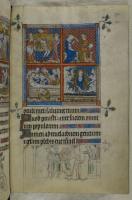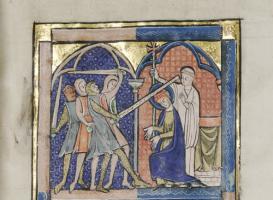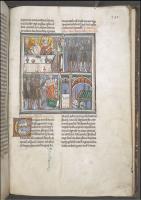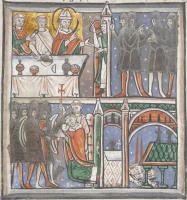Text this colour links to Pages. Text this colour links to Family Trees. Text this colour are links that are disabled for Guests.
Place the mouse over images to see a larger image. Click on paintings to see the painter's Biography Page. Mouse over links for a preview. Move the mouse off the painting or link to close the popup.
1162 Thomas Becket appointed Archbishop of Canterbury
1164 Constitutions of Clarendon
1164 Becket's Relatives Banished
1170 Murder of Thomas a Becket
On 21st December 1119, or 1120, the Feast Day of St Thomas the Apostle, Archbishop Thomas Becket was born. His father was Gilbert, and grandfather from Thierville in Brionne in Normandy. His mother was Matilda; also of Norman descent.
In 1162 William Plantagenet (age 25) was to marry Isabella Warenne Countess Boulogne 4th Countess of Surrey (age 25) but Archbishop Thomas Becket (age 42) refused to grant the necessary dispensation.
On 23rd May 1162 Archbishop Thomas Becket (age 42) was elected Archibishop Canterbury by King Henry "Curtmantle" II of England (age 29).
On 2nd June 1162 Archbishop Thomas Becket (age 42) was ordained.
On 3rd June 1162 Archbishop Thomas Becket (age 42) was consecrated Archibishop Canterbury by Bishop Henry of Blois (age 64).
On 24th May 1162 Archbishop Thomas Becket (age 42) was appointed Archbishop of Canterbury.
Around 1163 Bishop Gilbert Foliot served as Clerk to Archbishop Thomas Becket (age 43).
On 22nd December 1163 Bishop Robert Melun (age 63) was consecrated Bishop of Hereford by Archbishop Thomas Becket (age 44) at Canterbury Cathedral [Map].
On 25th January 1164 King Henry "Curtmantle" II of England (age 30) attempted to constrain ecclesiastical privileges by the sixteen articles of the Constitutions of Clarendon. Archbishop Thomas Becket (age 44) rejected the articles.
On 30th January 1164 William Plantagenet (age 27) died. He was buried at Notre Dame de Paris Cathedral [Map]. His death said to have been of a broken heart since he was unable to marry Isabella Warenne Countess Boulogne 4th Countess of Surrey (age 27) as a result of Archbishop Thomas Becket (age 44) refusing to grant the necessary dispensation. His death may have been the start of the rift between his elder brother King Henry II (age 30) and Becket.
In October 1164 Archbishop Thomas Becket (age 44) was put on trial in Northampton [Map] by King Henry "Curtmantle" II of England (age 31) on a charge of contempt. After a week of discussion Becket fled to Flanders with Bishop John of Salisbury (age 46).
In 26th December 1164 King Henry "Curtmantle" II of England (age 31) banished all of Thomas Becket's (age 45) relatives from England. Around 400 people were affected. They were stripped of their possessions and shipped to Flanders.
Letters. 1165. Letter IV. Empress Matilda (age 62) to Archbishop Thomas Becket (age 45).
To Thomas archbishop of Canterbury, Matilda the empress.
My lord pope sent to me, enjoining me, for the remission of my sins, to interfere to renew peace and concord between you and the king, my son (age 31), and to try to reconcile you to him. You, as you well know, have asked the same thing from me; wherefore, with the more good-will, for the honour of God and the Holy Church, I have begun and carefully treated of that affair. But it seems a very hard thing to the king, as well as to his barons and council, seeing he so loved and honoured you, and appointed you lord of his whole kingdom and of all his lands, and raised you to the highest honours in the land, believing he might trust you rather than any other; and especially so, because he declares that you have, as far as you could, roused his whole kingdom against him; nor was it your fault that you did not disinherit him by main force. Therefore I send you my faithful servant, Archdeacon Laurence, that by him I may know your will in these affairs, and what sort of disposition you entertain towards my son, and how you intend to conduct yourself, if it should happen that he fully grants my petition and prayer on your behalf. One thing I plainly tell you, that you cannot recover the king's favour, except by great humility and most evident moderation. However, what you intend to do in this matter signify to me by my messenger and your letters.
In 1170 Bishop Jocelin de Bohun (age 59) was excommunicated by Archbishop Thomas Becket (age 50) ostensibly for having assisted in the coronation of Henry the Young King, son of Henry II.
On 29th December 1170 Archbishop Thomas Becket (age 51) was murdered at Canterbury Cathedral [Map] by four knights on behalf of King Henry "Curtmantle" II of England (age 37). Whether Henry ordered the murder, or whether the four knights were acting without orders, is a matter of conjecture. The first use of the well-known phrase "Will no-one rid me of this turbulent priest" appears some five hundred and more years later in Robert Dodsley's 1740 Chronicle of the Kings of England.

29th December 1170. A bas-de-page image illustrating the murder of Archbishop Thomas Becket (age 51), from the Queen Mary Psalter: England (London/Westminster or East Anglia?) between 1310 and 1320, Royal MS 2 B VII, f. 298r.

29th December 1170. Archbishop Thomas Becket (age 51) is murdered by a group of knights; BL Add MS 38116; 'The Huth Psalter'; 1280 CE-1300 CE; England,N.; f.13r.
All About History Books
The Chronicle of Abbot Ralph of Coggeshall describes the reigns of Kings Henry II, Richard I, John and Henry III, providing a wealth of information about their lives and the events of the time. Ralph's work is detailed, comprehensive and objective. We have augmented Ralph's text with extracts from other contemporary chroniclers to enrich the reader's experience. Available at Amazon in eBook and Paperback.
29th December 1170. Earliest known depiction of the murder of Archbishop Thomas Becket (age 51). BL Cotton MS Claudius B II; Alan of Tewkesbury, Collectio Epistolarum Sancti Thome Cantuariensis; 12th c; England; f.341r.


On 7th July 1220 the remains of Archbishop Thomas Becket were translated from the crypt of Canterbury Cathedral [Map] to an elaborate shrine in the newly-constructed apse at the east end of the cathedral. King Henry III of England (age 12) was in attendance, together with the political and religious great and good, and a new liturgical office was composed for the occasion.
In September 1538 Henry VIII (age 47) ordered Thomas of Becket's shrine at Canterbury Cathedral [Map] to be destroyed. Both an attack on the Catholic Church, and a means to generate revenue; Thomas' shrine was covered in precious metals and stones. Two huges chests, each requiring six men to carry, were required to remove the treasure.
On 16th November 1538 Henry VIII (age 47) attacked Thomas of Becket's reputation, removing his canonisation at the same time.
Henry enacted legislation as follows:
ITEM, for as moche as it appereth now clerely, that Thomas Becket, sometyme Archbyshop of Canterburie, stubburnly to withstand the holsome lawes establyshed agaynste the enormities of the clergie, by the kynges highness mooste noble progenitour, kynge HENRY the Seconde, for the common welthe, reste, and tranquillitie of this realme, of his frowarde mynde fledde the realme into Fraunce, and to the bishop of Rome, mayntenour of those enormities, to procure the abrogation of the sayd lawes, whereby arose moch trouble in this said realme, and that his dethe, which they untruely called martyrdome, happened upon a reskewe by him made, and that, as it is written, he gave opprobrious wordes to the gentyllmen, whiche than counsayled hym to leave his stubbernesse, and to avoyde the commocion of the people, rysen up for that rescue. And he not only callyd the one of them bawde, but also toke Tracy by the bosome, and violently shoke and plucked hym in suche maner, that he had almoste overthrowen hym to the pavement of the Churche; so that upon this fray one of their company, perceivynge the same, strake hym, and so in the thronge Becket was slayne. And further that his canonization was made onely by the bysshop of Rome, bycause he had ben a champion of maynteyne his usurped auctoritie, and a bearer of the iniquitie of the clergie, for these and for other great and urgent causes, longe to recyte, the Kynge's Maiestie, by the advyse of his counsayle, hath thought expedient to declare to his lovynge subjectes, that notwithstandynge the sayde canonization, there appereth nothynge in his lyfe and exteriour conversation, wherby he shuld be callyd a sainct, but rather estemed to have ben a rebell and traytour to his prynce. Therefore his Grace strayghtly chargeth and commandeth that from henseforth the sayde Thomas Becket shall not be estemed, named, reputed, nor called a sayncte, but bysshop Becket; and that his ymages and pictures, through the hole realme, shall be putte downe, and avoyded out of all churches, chapelles, and other places; and that from henseforthe, the dayes used to be festivall in his name shall not be observed, nor the service, office, antiphoners, colletes, and prayers, in his name redde, but rased and put out of all the bokes.
![]() Become a Member via our Buy Me a Coffee page to read complete text.
Become a Member via our Buy Me a Coffee page to read complete text.